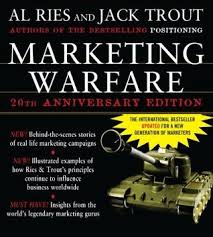Marketing Warfare, a concept popularized by Al Ries and Jack Trout in their seminal book of the same name, draws parallels between business competition and military strategy. It posits that businesses must approach the market with a strategic, competitive mindset, identifying and exploiting weaknesses in the competitive landscape. This white paper explores the key principles of Marketing Warfare and their application in today's dynamic business environment.
Marketing Warfare: A White Paper
1. Introduction
Marketing Warfare, a concept popularized by Al Ries and Jack Trout in their seminal book of the same name, draws parallels between business competition and military strategy. It posits that businesses must approach the market with a strategic, competitive mindset, identifying and exploiting weaknesses in the competitive landscape. This white paper explores the key principles of Marketing Warfare and their application in today's dynamic business environment.
2. Core Principles of Marketing Warfare
- Focus: Concentrate all marketing efforts on a single, well-defined market niche. Avoid trying to be everything to everyone.
- Example: Red Bull's focus on the energy drink market, rather than competing directly with Coca-Cola in the broader beverage market.
- Leadership: Strive to be the first in the mind of the consumer in a particular category.
- Example: FedEx and its "When it absolutely, positively has to be there overnight" positioning.
- Positioning: Create a unique and defensible position in the marketplace.
- Example: 7-Eleven's positioning as the "convenient store" rather than just another gas station.
- Offensive vs. Defensive Strategies:
- Offensive: For challengers, focus on attacking the leader's weaknesses and exploiting market opportunities.
- Defensive: For market leaders, focus on protecting market share and maintaining a strong competitive advantage.
- Flanking Maneuvers: Attack competitors indirectly by targeting underserved markets or developing innovative new product categories.
- Example: Nintendo's success with the Wii, targeting a broader audience beyond traditional gamers.
- Guerrilla Warfare: Employ unconventional and disruptive tactics to gain market share, particularly for smaller companies with limited resources.
- Example: Using social media and viral marketing to generate buzz and awareness.
3. Applying Marketing Warfare in the Modern Era
- Digital Marketing:
- Search Engine Optimization (SEO): Dominate search engine results pages (SERPs) to gain visibility and drive traffic.
- Social Media Marketing: Utilize social media platforms to build brand awareness, engage with customers, and gather market intelligence.
- Content Marketing: Create high-quality, valuable content to attract and engage target audiences.
- Competitive Intelligence: Continuously monitor competitor activities, analyze market trends, and identify emerging threats and opportunities.
- Innovation: Continuously innovate and adapt to the changing needs of the market.
- Customer Focus: While competitor-centric, Marketing Warfare should always be grounded in understanding customer needs and preferences.
4. Ethical Considerations
While Marketing Warfare emphasizes competitive advantage, it is crucial to maintain ethical business practices.
- Avoid deceptive or misleading marketing tactics.
- Respect competitors and their intellectual property.
- Prioritize customer satisfaction and long-term relationships.
5. Conclusion
Marketing Warfare provides a valuable framework for businesses to develop and execute effective competitive strategies. By understanding the principles of focus, leadership, positioning, and offensive/defensive strategies, businesses can navigate the competitive landscape, gain market share, and achieve sustainable success.
References
- Ries, A., & Trout, J. (1997). Marketing Warfare. McGraw-Hill.
- Kotler, P., & Armstrong, G. (2021). Principles of Marketing. Pearson.
- Porter, M. E. (1980). Competitive Strategy: Techniques for Analyzing Industries and Competitors. Free Press.
Disclaimer: This white paper provides a general overview of Marketing Warfare. It is not intended as financial or investment advice. The information provided in this document is for informational purposes only and should not be considered as a substitute for professional advice.
Note: This is a sample white paper and may require further research and customization to meet specific needs and industry requirements. Contact keencomputer.com for details.
